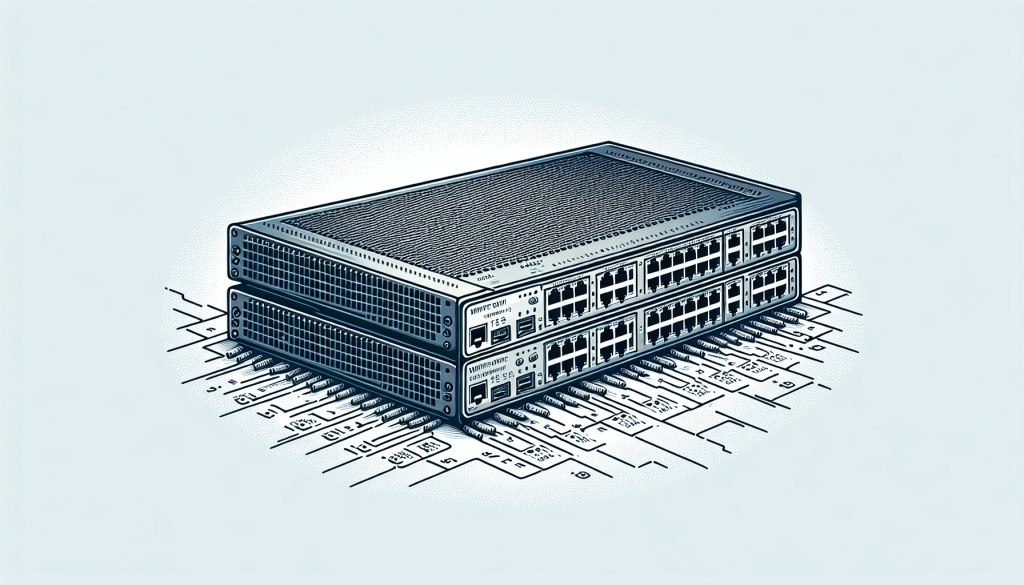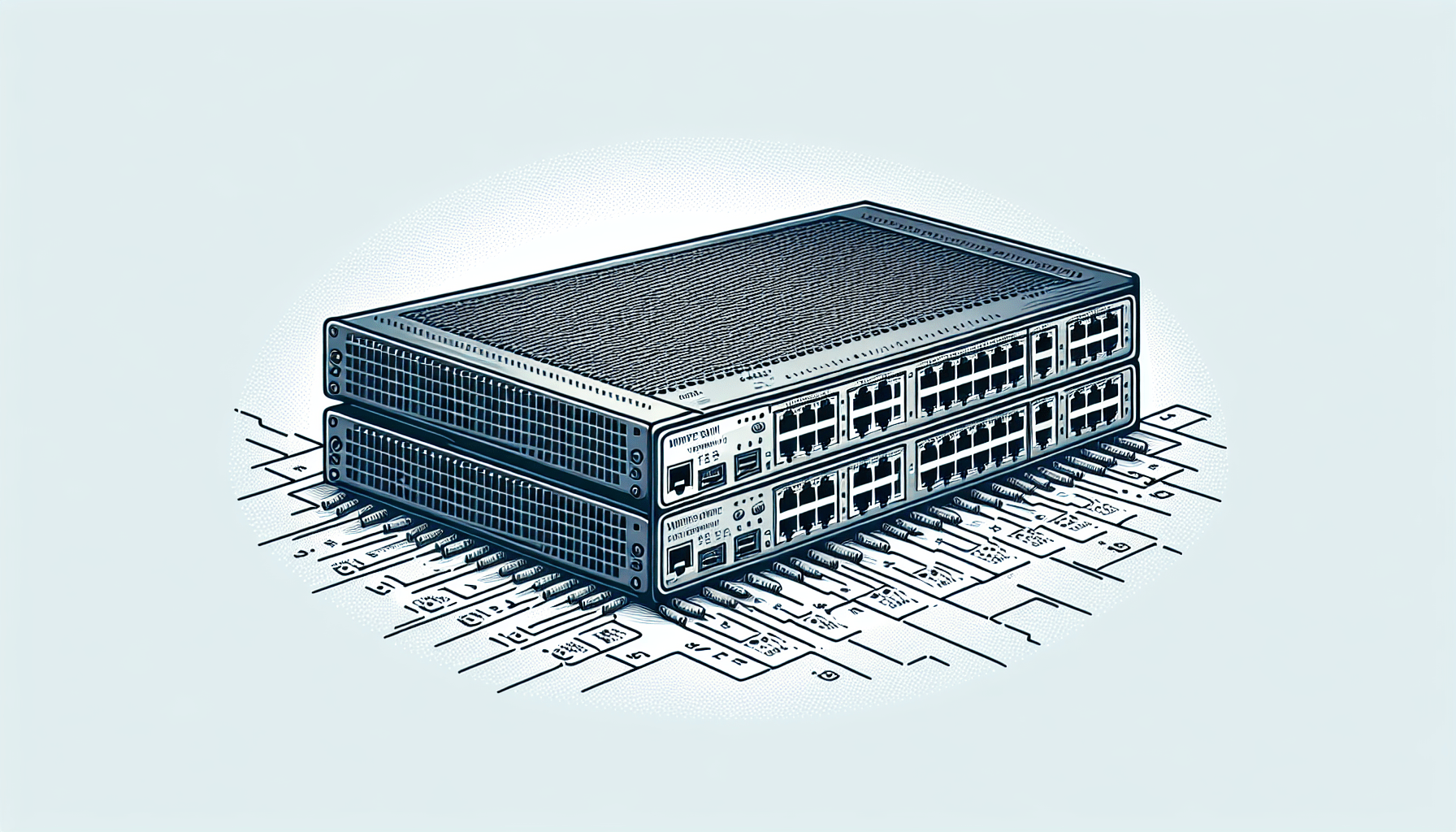In the world of large organizations, the reliance on a robust and efficient network infrastructure cannot be underestimated. A key component of this infrastructure is a managed network switch, which plays a pivotal role in ensuring seamless communication and data management across the organization. From enhancing network security to optimizing network performance, managed network switches are vital for keeping operations running smoothly. In this article, we will explore the importance of these switches in large organizations and the benefits they bring to the table. So, let’s dive in and uncover the fundamental role managed network switches play in maintaining a well-oiled network environment.
Improved Network Performance
In large organizations, network performance is crucial for ensuring smooth operations and maximum productivity. Managed network switches play a significant role in enhancing network performance through various features.
Bandwidth Management
With the increasing number of devices and applications relying on the network, bandwidth management becomes essential to prevent excessive congestion and ensure fair resource allocation. Managed switches offer advanced bandwidth management capabilities, allowing you to prioritize critical traffic and allocate bandwidth effectively.
Quality of Service (QoS)
Guaranteeing a certain level of service for specific types of network traffic is vital in large organizations. Managed network switches offer QoS functionality, enabling you to prioritize critical applications, such as voice or video, over less time-sensitive traffic. This ensures that important data is transmitted with minimal delay, ensuring a smooth user experience.
Reduced Network Congestion
In a large organization, network congestion can drastically impact performance, leading to delays and bottlenecks. Managed switches come equipped with features like port mirroring and flow control, allowing you to monitor and control network traffic effectively. By preventing congestion and optimizing traffic flow, managed switches ensure seamless communication and improved network performance.
Enhanced Security
Securing the network infrastructure is imperative for large organizations, considering the potential risks and sensitive data involved. Managed network switches offer several security features to protect against unauthorized access and potential vulnerabilities.
Access Control
Managed switches provide robust access control mechanisms, allowing you to define granular access policies for individual ports or groups. This ensures that only authorized devices or users can connect to the network, reducing the risk of unauthorized access and potential security breaches.
VLAN Segmentation
Virtual Local Area Network (VLAN) segmentation helps improve network security by logically separating different parts of the network. Managed switches allow you to create multiple VLANs, isolating sensitive departments or segments from each other. This prevents unauthorized access between VLANs, enhancing overall network security.
Traffic Monitoring
Visibility into network traffic is vital for identifying potential security threats and ensuring compliance with internal policies. Managed switches offer comprehensive traffic monitoring capabilities, enabling you to analyze network traffic patterns, detect anomalies, and identify potential security breaches. This proactive approach enhances network security by allowing you to take necessary action promptly.
Centralized Network Management
Managing a large network can be complex and time-consuming. Managed network switches simplify network management through centralized control and monitoring capabilities.
Configuration and Firmware Updates
Configuring and updating numerous switches individually can be a daunting task. Managed switches empower you to centrally manage configuration changes and firmware updates, ensuring consistency across the network. This saves time and effort while reducing the chances of configuration errors.
Network Troubleshooting
Troubleshooting network issues promptly is crucial for minimizing downtime and maintaining productivity. Managed switches provide advanced diagnostic tools and remote management capabilities, allowing network administrators to identify and rectify issues more efficiently. With enhanced troubleshooting capabilities, potential network issues can be swiftly resolved, reducing overall downtime.
Network Monitoring
Staying on top of network performance and detecting potential problems is critical for large organizations. Managed switches offer comprehensive network monitoring features, enabling real-time monitoring of network health, traffic patterns, and performance metrics. By proactively monitoring the network, potential issues can be identified and addressed before they impact operations, ensuring uninterrupted connectivity.

Scalability and Flexibility
As organizations grow and evolve, their networking needs change. Managed network switches are designed to provide the scalability and flexibility required to adapt to changing business requirements.
Easy Network Expansion
Managed switches facilitate easy network expansion by allowing additional switches to be seamlessly added to the existing infrastructure. With features like VLAN support and link aggregation, expanding the network becomes a smooth process, ensuring consistent connectivity and optimal performance.
Support for Multiple Network Types
Large organizations often employ a mix of wired and wireless network technologies to cater to diverse connectivity requirements. Managed switches offer support for various network types, including Ethernet, Fiber, and Power over Ethernet (PoE), providing the flexibility needed to accommodate different networking environments.
Interoperability
In a complex network ecosystem, seamless integration and interoperability between various network components are crucial. Managed switches are designed to integrate seamlessly with other networking devices, such as routers and firewalls, ensuring smooth communication and interoperability. This facilitates the creation of unified network architectures, enhancing overall network efficiency.
Optimized Resource Utilization
Efficient resource utilization is essential for large organizations to maximize network performance and minimize costs. Managed network switches offer several features aimed at optimizing resource allocation and utilization.
Load Balancing
Load balancing evenly distributes network traffic across multiple paths, preventing bottlenecks and ensuring optimal bandwidth utilization. Managed switches provide load balancing capabilities, allowing you to distribute traffic based on various parameters, such as port utilization or application type. This ensures efficient utilization of network resources and optimal performance.
Redundancy and Failover
Ensuring high availability and minimizing network downtime is crucial for large organizations. Managed switches offer features like redundant power supplies and support for Link Aggregation Control Protocol (LACP), enabling automatic failover in case of a network component failure. With redundancy and failover capabilities, network downtime is minimized, ensuring uninterrupted connectivity.
Virtualization Support
Virtualization has become a key aspect of modern network infrastructures. Managed switches provide comprehensive support for virtualization, allowing you to create and manage network virtualization solutions efficiently. This facilitates the deployment of virtual machines, virtual networks, and virtual appliances with ease, optimizing resource utilization and network efficiency.
Advanced Network Features
Managed switches offer advanced network features that further enhance overall network performance and flexibility.
Spanning Tree Protocol
The Spanning Tree Protocol (STP) is a network protocol that prevents loops in Ethernet networks. Managed switches implement STP, ensuring loop-free paths and preventing network disruptions caused by broadcasts or faulty configurations. By eliminating data loop errors, STP ensures reliable and efficient network operation.
Link Aggregation
Link aggregation, also known as port trunking, combines multiple physical links into a single logical link, increasing available bandwidth and improving network performance. Managed switches support link aggregation, allowing you to bundle multiple network links for increased capacity, redundancy, and load balancing.
Multicast Support
Multicast enables efficient distribution of data to multiple recipients simultaneously. Managed switches provide multicast support, allowing network administrators to distribute data streams, such as video or audio broadcasts, to multiple devices without overwhelming the network. This enhances network efficiency by reducing unnecessary traffic and optimizing resource usage.
Improved Troubleshooting and Diagnostics
Managed network switches offer advanced troubleshooting and diagnostic capabilities, empowering network administrators to identify and resolve network issues efficiently.
Port Mirroring
Port mirroring allows the monitoring of traffic on a specific port by duplicating it to another port. Managed switches support port mirroring, enabling network administrators to capture and analyze network packets for troubleshooting or security purposes. By monitoring specific ports, potential network issues can be identified and resolved swiftly.
Packet Capture
Capturing network packets is crucial for in-depth analysis of network traffic and identification of potential issues. Managed switches provide packet capture capabilities, allowing network administrators to capture packets directly from the switch and analyze them using network analysis tools. This enables comprehensive network troubleshooting and faster issue resolution.
Network Traffic Analysis
Understanding network traffic patterns and behavior is essential for optimizing network performance and identifying potential security threats. Managed switches offer network traffic analysis capabilities, providing detailed insights into network utilization, application performance, and user behavior. By analyzing network traffic, network administrators can identify bandwidth-intensive applications, detect anomalies, and take necessary measures to enhance network performance.
Cost Savings
Managed network switches offer several cost-saving benefits for large organizations, making them a valuable investment.
Reduced Equipment Costs
Managed switches consolidate various network functionalities into a single device, reducing the need for additional network infrastructure. This consolidation results in significant cost savings by eliminating the need for multiple devices, cables, and power sources. Additionally, the scalability of managed switches allows organizations to plan their network growth effectively, minimizing the risk of overspending on unnecessary equipment.
Lower Maintenance Costs
Managing network infrastructure can incur significant maintenance costs, especially in large organizations. Managed network switches simplify maintenance by providing centralized management and control capabilities. With features like remote configuration and firmware updates, organizations can reduce the need for on-site maintenance visits, resulting in lower maintenance costs and increased operational efficiency.
Higher ROI
Investing in managed network switches yields a high return on investment (ROI) for large organizations. With improved network performance, enhanced security, and optimized network resource utilization, organizations benefit from increased productivity, reduced downtime, and improved overall efficiency. The cost savings achieved through reduced equipment costs and lower maintenance expenses further contribute to a higher ROI, making managed switches an essential component of a successful network infrastructure.
Efficient Network Segmentation
Efficient network segmentation is vital for large organizations that need to separate departments, protect sensitive data, and comply with regulatory requirements. Managed network switches offer robust network segmentation capabilities to address these needs effectively.
Departmental Isolation
Segmenting the network based on departments provides enhanced security and isolation, allowing departments to operate independently while maintaining centralized network management. Managed switches enable the creation of separate VLANs for each department, ensuring complete isolation and secure communication. This segregation minimizes the risk of unauthorized access and data breaches, fostering a secure and collaborative work environment.
Guest Network Isolation
Hosting visitors and external partners often requires separate network access without compromising internal network security. Managed switches offer guest network isolation capabilities, enabling the creation of separate VLANs or wireless networks for guest users. This ensures that guest devices are isolated from the core internal network, safeguarding sensitive data while providing seamless connectivity for visitors.
Compliance with Regulatory Requirements
Many large organizations operate in industries that are subject to specific regulatory requirements regarding data privacy and security. Managed switches help organizations comply with these regulations by implementing stringent access controls, network segmentation, and traffic monitoring. By delivering a secure and auditable network infrastructure, organizations can ensure compliance with industry regulations and avoid costly penalties.
Reliable Network Connectivity
Reliable network connectivity is paramount for large organizations to maintain seamless operations and productivity. Managed network switches offer features that enhance network reliability and ensure uninterrupted connectivity.
Redundant Power Supplies
Power outages or power supply failures can severely impact network availability. Managed switches provide redundant power supply options, allowing you to connect multiple power sources and ensuring continuous operation even if one power source fails. This redundancy improves network uptime and minimizes the risk of downtime due to power-related issues.
Hot Swappable Modules
When network components require maintenance or replacement, minimizing downtime becomes crucial. Managed switches come equipped with hot swappable modules, allowing network administrators to replace faulty modules without interrupting network connectivity. This feature enables quick and seamless module replacement, enhancing network reliability and minimizing potential disruptions.
Quality Hardware Components
The reliability of a network infrastructure heavily depends on the quality of its components. Managed switches are built using high-quality components, including robust hardware and advanced chipsets, ensuring stable and reliable operation. These quality components are designed to withstand the demands of large networks, providing long-lasting performance and stability.
In conclusion, managed network switches are essential for large organizations to achieve improved network performance, enhanced security, centralized network management, scalability, resource optimization, advanced network features, efficient troubleshooting, cost savings, efficient network segmentation, and reliable connectivity. By investing in managed switches, organizations can build a robust and future-ready network infrastructure that meets their evolving needs and ensures seamless operations for maximum productivity.
